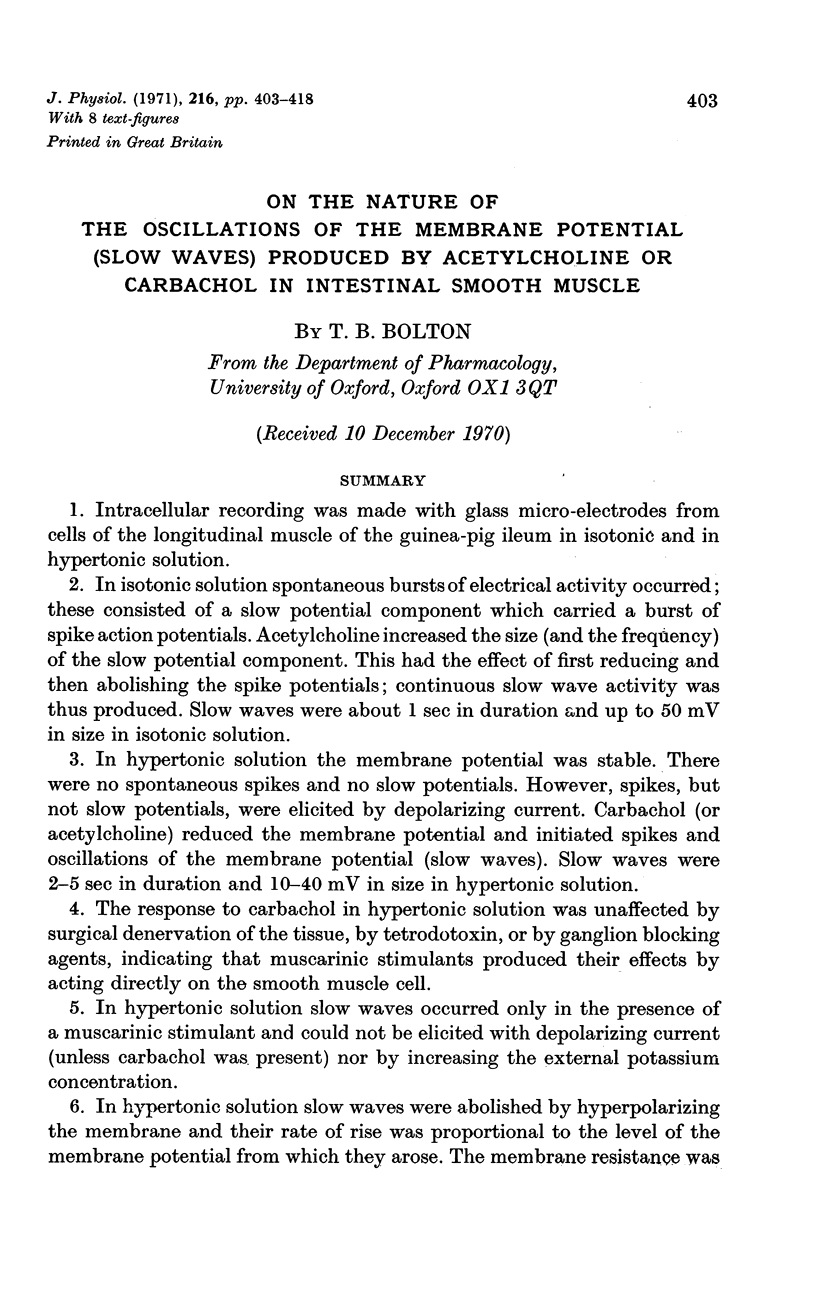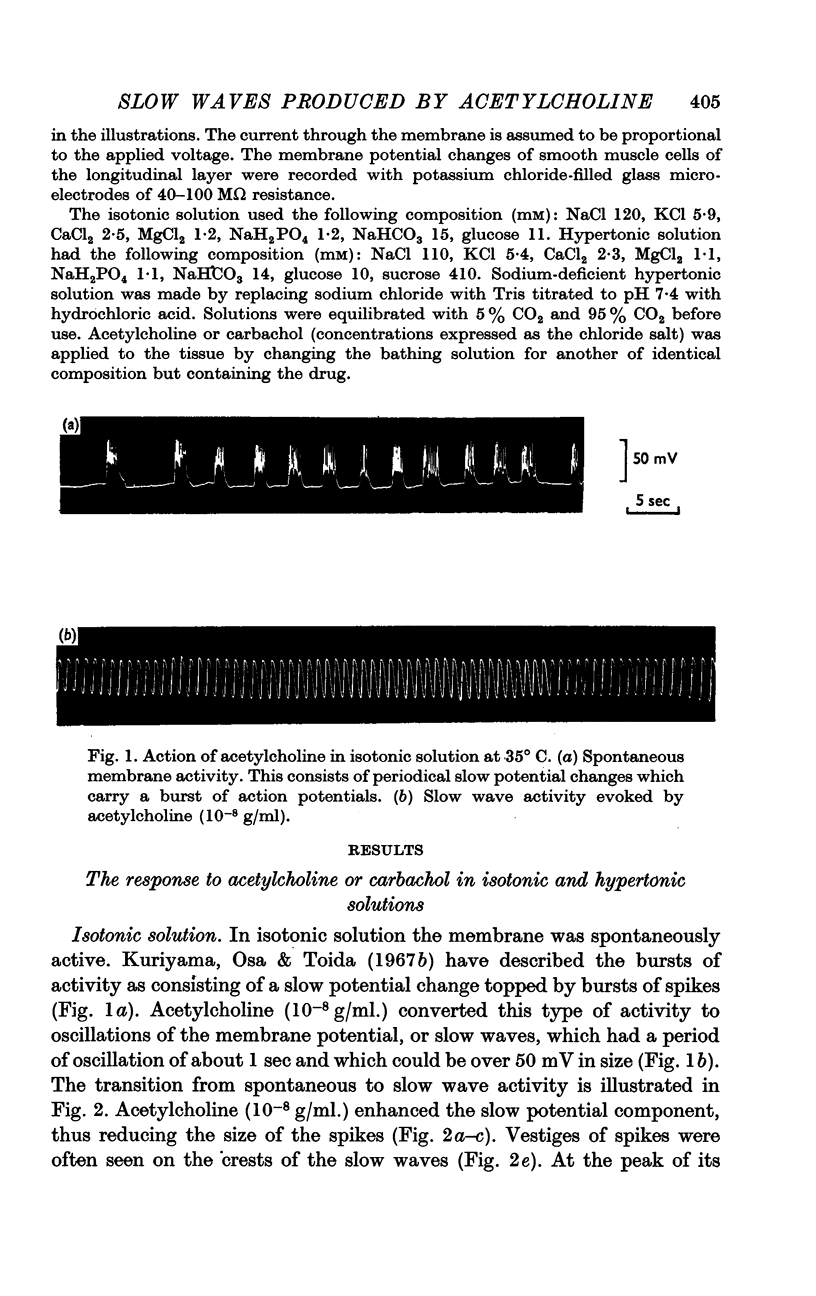Abstract
1. Intracellular recording was made with glass micro-electrodes from cells of the longitudinal muscle of the guinea-pig ileum in isotonic and in hypertonic solution.
2. In isotonic solution spontaneous bursts of electrical activity occurred; these consisted of a slow potential component which carried a burst of spike action potentials. Acetylcholine increased the size (and the frequency) of the slow potential component. This had the effect of first reducing and then abolishing the spike potentials; continuous slow wave activity was thus produced. Slow waves were about 1 sec in duration and up to 50 mV in size in isotonic solution.
3. In hypertonic solution the membrane potential was stable. There were no spontaneous spikes and no slow potentials. However, spikes, but not slow potentials, were elicited by depolarizing current. Carbachol (or acetylcholine) reduced the membrane potential and initiated spikes and oscillations of the membrane potential (slow waves). Slow waves were 2-5 sec in duration and 10-40 mV in size in hypertonic solution.
4. The response to carbachol in hypertonic solution was unaffected by surgical denervation of the tissue, by tetrodotoxin, or by ganglion blocking agents, indicating that muscarinic stimulants produced their effects by acting directly on the smooth muscle cell.
5. In hypertonic solution slow waves occurred only in the presence of a muscarinic stimulant and could not be elicited with depolarizing current (unless carbachol was present) nor by increasing the external potassium concentration.
6. In hypertonic solution slow waves were abolished by hyperpolarizing the membrane and their rate of rise was proportional to the level of the membrane potential from which they arose. The membrane resistance was reduced at the peak of the slow wave. Slow waves were rapidly abolished by sodium-deficient solutions but spikes were not.
7. It is suggested that slow waves represent an inward current through a slow, sodium-sensitive and voltage-dependent ion channel, and that acetylcholine or carbachol increase, while hypertonic solution decreases, the current carried by this channel.
Full text
PDF















Selected References
These references are in PubMed. This may not be the complete list of references from this article.
- Abe Y., Tomita T. Cable properties of smooth muscle. J Physiol. 1968 May;196(1):87–100. doi: 10.1113/jphysiol.1968.sp008496. [DOI] [PMC free article] [PubMed] [Google Scholar]
- BULBRING E. Correlation between membrane potential, spike discharge and tension in smooth muscle. J Physiol. 1955 Apr 28;128(1):200–221. doi: 10.1113/jphysiol.1955.sp005299. [DOI] [PMC free article] [PubMed] [Google Scholar]
- BULBRING E., KURIYAMA H. Effects of changes in ionic environment on the action of acetylcholine and adrenaline on the smooth muscle cells of guinea-pig taenia coli. J Physiol. 1963 Apr;166:59–74. doi: 10.1113/jphysiol.1963.sp007090. [DOI] [PMC free article] [PubMed] [Google Scholar]
- BULBRING E. Membrane potentials of smooth muscle fibres of the taenia coli of the guinea-pig. J Physiol. 1954 Aug 27;125(2):302–315. doi: 10.1113/jphysiol.1954.sp005159. [DOI] [PMC free article] [PubMed] [Google Scholar]
- DURBIN R. P., JENKINSON D. H. The effect of carbachol on the permeability of depolarized smooth muscle to inorganic ions. J Physiol. 1961 Jun;157:74–89. doi: 10.1113/jphysiol.1961.sp006706. [DOI] [PMC free article] [PubMed] [Google Scholar]
- Elmqvist D., Feldman D. S. Spontaneous activity at a mammalian neuromuscular junction in tetrodotoxin. Acta Physiol Scand. 1965 Aug;64(4):475–476. doi: 10.1111/j.1748-1716.1965.tb04206.x. [DOI] [PubMed] [Google Scholar]
- FATT P., KATZ B. An analysis of the end-plate potential recorded with an intracellular electrode. J Physiol. 1951 Nov 28;115(3):320–370. doi: 10.1113/jphysiol.1951.sp004675. [DOI] [PMC free article] [PubMed] [Google Scholar]
- FELDBERG W., LIN R. C. Y. The effect of cocaine on the acetylcholine output of the intestinal wall. J Physiol. 1949 Sep;109(3-4):475–487. doi: 10.1113/jphysiol.1949.sp004410. [DOI] [PMC free article] [PubMed] [Google Scholar]
- Ginsborg B. L. Ion movements in junctional transmission. Pharmacol Rev. 1967 Sep;19(3):289–316. [PubMed] [Google Scholar]
- Hauswirth O., Noble D., Tsien R. W. Adrenaline: mechanism of action on the pacemaker potential in cardiac Purkinje fibers. Science. 1968 Nov 22;162(3856):916–917. doi: 10.1126/science.162.3856.916. [DOI] [PubMed] [Google Scholar]
- Hidaka T., Kuriyama H. Responses of the smooth muscle membrane of guinea pig jejunum elicited by field stimulation. J Gen Physiol. 1969 Apr;53(4):471–486. doi: 10.1085/jgp.53.4.471. [DOI] [PMC free article] [PubMed] [Google Scholar]
- Jenkinson D. H., Morton I. K. The effect of noradrenaline on the permeability of depolarized intestinal smooth muscle to inorganic ions. J Physiol. 1967 Feb;188(3):373–386. doi: 10.1113/jphysiol.1967.sp008144. [DOI] [PMC free article] [PubMed] [Google Scholar]
- KOELLE G. B. A new general concept of the neurohumoral functions of acetylcholine and acetylcholinesterase. J Pharm Pharmacol. 1962 Feb;14:65–90. doi: 10.1111/j.2042-7158.1962.tb11057.x. [DOI] [PubMed] [Google Scholar]
- Kuriyama H., Osa T., Toida N. Electrophysiological study of the intestinal smooth muscle of the guinea-pig. J Physiol. 1967 Jul;191(2):239–255. doi: 10.1113/jphysiol.1967.sp008248. [DOI] [PMC free article] [PubMed] [Google Scholar]
- Kuriyama H., Osa T., Toida N. Membrane properties of the smooth muscle of guinea-pig ureter. J Physiol. 1967 Jul;191(2):225–238. doi: 10.1113/jphysiol.1967.sp008247. [DOI] [PMC free article] [PubMed] [Google Scholar]
- Kuriyama H., Osa T., Toida N. Nervous factors influencing the membrane activity of intestinal smooth muscle. J Physiol. 1967 Jul;191(2):257–270. doi: 10.1113/jphysiol.1967.sp008249. [DOI] [PMC free article] [PubMed] [Google Scholar]
- Kuriyama H., Tomita T. The action potential in the smooth muscle of the guinea pig taenia coli and ureter studied by the double sucrose-gap method. J Gen Physiol. 1970 Feb;55(2):147–162. doi: 10.1085/jgp.55.2.147. [DOI] [PMC free article] [PubMed] [Google Scholar]
- Landau E. M. The interaction of presynaptic polarization with calcium and magnesium in modifying spontaneous transmitter release from mammalian motor nerve terminals. J Physiol. 1969 Aug;203(2):281–299. doi: 10.1113/jphysiol.1969.sp008864. [DOI] [PMC free article] [PubMed] [Google Scholar]
- Maeno T. Analysis of sodium and potassium conductances in the procaine end-plate potential. J Physiol. 1966 Apr;183(3):592–606. doi: 10.1113/jphysiol.1966.sp007886. [DOI] [PMC free article] [PubMed] [Google Scholar]
- Miledi R. Spontaneous synaptic potentials and quantal release of transmitter in the stellate ganglion of the squid. J Physiol. 1967 Sep;192(2):379–406. doi: 10.1113/jphysiol.1967.sp008306. [DOI] [PMC free article] [PubMed] [Google Scholar]
- Paton W. D., Zar M. A. The origin of acetylcholine released from guinea-pig intestine and longitudinal muscle strips. J Physiol. 1968 Jan;194(1):13–33. doi: 10.1113/jphysiol.1968.sp008392. [DOI] [PMC free article] [PubMed] [Google Scholar]
- TAKEUCHI A., TAKEUCHI N. Active phase of frog's end-plate potential. J Neurophysiol. 1959 Jul;22(4):395–411. doi: 10.1152/jn.1959.22.4.395. [DOI] [PubMed] [Google Scholar]
- TAKEUCHI A., TAKEUCHI N. On the permeability of end-plate membrane during the action of transmitter. J Physiol. 1960 Nov;154:52–67. doi: 10.1113/jphysiol.1960.sp006564. [DOI] [PMC free article] [PubMed] [Google Scholar]
- Tomita T. Electrical responses of smooth muscle to external stimulation in hypertonic solution. J Physiol. 1966 Mar;183(2):450–468. doi: 10.1113/jphysiol.1966.sp007876. [DOI] [PMC free article] [PubMed] [Google Scholar]
- Vassort G., Rougier O., Garnier D., Sauviat M. P., Coraboeuf E., Gargouïl Y. M. Effects of adrenaline on membrane inward currents during the cardiac action potential. Pflugers Arch. 1969;309(1):70–81. doi: 10.1007/BF00592283. [DOI] [PubMed] [Google Scholar]


